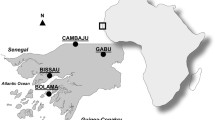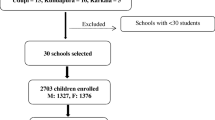Abstract
Iodine deficiency is a major health problem worldwide. The environment of the Balkan countries, including Bulgaria, is distinguished for its low iodine content. In 1994, the strategies for the prevention and control of iodine-deficiency disorders were actualized in Bulgaria and universal salt iodization and supplementation for the risk population groups (schoolchildren, pregnant women) were introduced. The aim of this study was to assess the effectiveness of the iodine prophylaxis in schoolchildren, living in an endemic for goiter area after the introduction of salt iodization in Bulgaria. For this purpose, the goiter prevalence and iodine status in 483 schoolchildren (274 boys and 209 girls) aged between 8 and 15 yr, living in an endemic for goiter area in Bulgaria were evaluated. Despite the normalization of iodine supply, mild iodine deficiency on the basis of goiter prevalence (16.15%) and urinary iodine excretion was found. These data indicate the need for reevaluation of the national strategy for prevention of iodine deficiency.
Similar content being viewed by others
References
L. Ivanova, Strategies for control of micronutrient deficiencies, inThe Science of Nutrition in Prevention of Human Health, B. Popov, ed., IK Blenda, Sofia, pp. 204–213 (2004).
International Council for the Control of Iodine Deficiency Disorders, WHO, UNICEF.Assessment of Iodine Deficiency Disorders and Monitoring Their Elimination. A Guide for Programme Managers, 2nd ed., WHO, Geneva (2001).
J. T. Dunn, H. E. Crutchfield, R. Gutekunst, and A. D. Dunn,Methods for Measuring Iodine in Urine, A joint publication of ICCIDD, UNICEF, and WHO, Wageningen, The Netherlands (1993).
T. Ohashi, M. Yamaki, C. S. Pandav, M. G. Karmarkar, and M. Irie, Simple microplate method for determination of urinary iodine,Clin. Chem. 46, 529–536 (2000).
D. Gnat, A. D. Dunn, S. Chaker, F. Delange, F. Vertongen, and J. T. Dunn, Fast colorimetric method for measuring urinary iodine,Clin. Chem. 49, 186–188 (2003).
M. Korpal-Szczyrska, B. Dorant, H. Kaminska, L. Bitel, D. Birkholz, and W. Kosiak, Effect of three years obligatory iodine prophylaxis on the incidence of goiter in school children from the seaside region of Poland.Pol. Merkuriusz. Lek. 16, 41–43 (2004).
F. Golkowski, B. Huszno, M. Trofimiuk, et al., Prevalence of goiter in schoolchildren: a study on the influence of adequate iodine prophylaxis in Poland,J. Endocrinol. Invest. 26,(Suppl. 2), 11–15 (2003).
H. Volzke, J. Ludemann, D. M. Robinson, et al., The prevalence of undiagnosed thyroid disorders in a previously iodine-deficient area,Thyroid 13, 803–810 (2003).
F. Delange, H. Burgi, Z. P. Chen, and J. T. Dunn, World status of monitoring iodine deficiency disorders control programs,Thyroid 12, 915–924 (2002).
U. Kapil, V. Sethi, G. Goindi, P. Pathak, and P. Singh, Elimination of iodine deficiency disorders in Delhi,Indian J. Pediatr. 71, 211–212 (2004).
C. Als, M. Haldimann, C. Minder, and H. Gerber, Pilot study of urinary iodine concentration and of biochemical thyroid parameters before and after cautious public health intervention on salt iodide content: the Swiss longitudinal 1996–2000 iodine study,Eur. J. Clin. Nutr. 58, 1201–1210 (2004).
J. Rendl, N. Juhran, and C. Reiners, Thyroid volumes and urinary iodine in German school children,Exp. Clin. Endocrinol. Diabetes 109, 8–12 (2001).
R. Hampel, A. Gordalla, H. Zollner, D. Klinke, and M. Demuth, Continuous rise of urinary iodine excretion and drop in thyroid gland size among adolescents in Mecklenburg-West-Pomerania from 1993 to 1997,Exp. Clin. Endocrinol. Diabetes 108, 197–201 (2000).
H. Burgi, L. Portmann, J. Podoba, F. Vertongen, and M. Srbecky, Thyroid volumes and urinary iodine in Swiss school children, 17 years after improved prophylaxis of iodine deficiency,Eur. J. Endocrinol. 140, 104–106 (1999).
M. V. Veldanova, The role of some goitrogenous environmental factors in the endemic goitre genesis,Trace Elements Med. (Russian) 1, 17–25 (2000).
Author information
Authors and Affiliations
Rights and permissions
About this article
Cite this article
Gatseva, P., Vladeva, S. & Argirova, M. Evaluation of endemic goiter prevalence in Bulgarian schoolchildren. Biol Trace Elem Res 116, 273–278 (2007). https://doi.org/10.1007/BF02698011
Received:
Accepted:
Issue Date:
DOI: https://doi.org/10.1007/BF02698011




